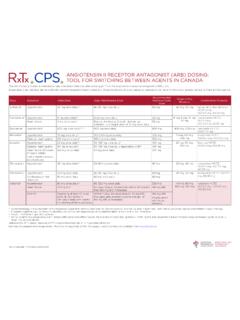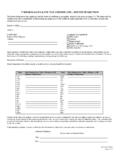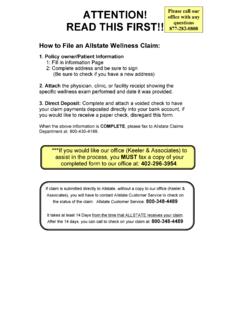Transcription of Influenza Immunization Guide for Pharmacists
1 1 Canadian Pharmacists Association 2012 THE FLU | INFLUENZAI nfluenza Immunization Guide for PharmacistsUpdated August 2012 THE FLU INFLUENZA2 Canadian Pharmacists Association 2012 THE FLU | INFLUENZAC onducting an Influenza Immunization Clinic Suggested Timelines ..3 Quick Facts About Influenza : The Virus and the Vaccine ..4 Criteria for Identifying Patients at High Risk of Influenza Complications ..6 Vaccination Administration Checklist and Storage Information ..7 Pharmacist Administration of a Drug by Injection Regulations by Province ..8 Appendix A Medications Indicative of High-Risk Patients ..9 Table of ContentsDisclaimerSome provinces have legislation that requires that informed consent be obtained from the patient prior to administration of vaccines . Consult your provincial regulatory body for more information . MAKE A HEALTHY yourself and those around you . GET THE FLU SHOT!3 Canadian Pharmacists Association 2012 THE FLU | INFLUENZAC onducting an Influenza Immunization ClinicIntroductionThe Canadian Pharmacists Association (CPhA), in collaboration with Immunize Canada (formerly Canadian Coalition for Immunization Awareness & Promotion, has developed the Influenza Immunization Guide so that Pharmacists , following a step-by-step Influenza program, can initiate Immunization clinics in their pharmacies.)
2 Many of your patients will appreciate this clinic; it also serves as an opportunity for you to market your professional services . The key is in communicating the value of your services to your patients . August to Determine if you have adequate resources to support the delivery of a September flu shot clinic . Consider the setting and staff availability . If you will be administering the Influenza vaccine yourself, schedule the date and time for the vaccination clinic . Ensure that you have all the information and docu-mentation required, including patient consent forms and any liability forms . If you do not have Immunization authority, contact a local nursing agency to set up a date and time for the vaccination clinic (agency to provide dosing charts, patient consent forms and any liability forms and administer vaccinations) .September Identify high-risk patients at the point of prescription pick-up and refills .through flu season September to Encourage patients to make an appointment.
3 Clinic date Place Vaccination Reminder Stickers on all prescription vials and provide bag stuffers (templates available online) with all prescriptions . Conduct telephone consultations with high-risk patients discuss benefits of vaccination and scheduling an appointment, document consultation in your patient records . 3 weeks Promote your vaccination clinic .before clinic Send letters to physicians, local retirement communities and/or all patients in your pharmacy database informing them about the clinic .2 weeks Place ads in local newspapers and radio; display posters in your pharmacy .before clinic Reconnect with vaccine supplier and nursing agency to confirm vaccine shipment and nurse attendance at clinic .Mid-October to Run Influenza Vaccination Clinic; document immunizations in your records or as mid-November agreed with local public health agency .Following year Send reminders to all past participants .Suggested TimelinesBe sure to involve staff members in your planning.
4 Take note of tasks that can be delegated to pharmacy staff ( pharmacy students and technicians).GoalTo increase overall number of patients immunized against Influenza , with a focus on those individuals at high risk of Influenza -related complications, those capable of transmitting Influenza to individuals at high risk of complications and those who provide essential community services . The recommendations found in the Guide are based on the National Advisory Committee for Immunization (NACI) 2012-2013 Influenza Immunization guidelines .1 }4 Canadian Pharmacists Association 2012 THE FLU | INFLUENZAQUICK FACTS ABOUT Influenza The Virus and the VaccineThe VirusInfluenza (the flu) is a serious, acute respiratory illness that is caused by Influenza viruses . It is spread by respiratory droplets from an infected person or direct contact with contaminated surfaces .The flu is caused by Influenza A and B viruses: Influenza A viruses are classified according to two different surface antigens.
5 There are three different human subtypes of the Hemagglutinin antigen (H1, H2 and H3) and two subtypes of the Neuraminidase antigen (N1 and N2) . Recently circulating strains (H3N2) have one H antigen and one N antigen which periodically undergo antigenic drift . Influenza B viruses have more stable antigens and so antigenic variation is less frequent but does occur .Continual antigenic drift of the Influenza virus means that a new vaccine, updated yearly with the most cur-rent circulating strains, is needed to protect against new VaccineAntigens from two strains of Influenza A and one strain of Influenza B are selected basedon the three most prevalent Influenza strainsexpected to be circulating that year . ComponentsA) The Virus The World Health Organization (WHO) recommends that the trivalent vaccine for the 2012 2013 season in the Northern Hemisphere contain the following strains: A/California/7/2009 (H1N1)pdm09-like virus A/Victoria/361/2011 (H3N2)-like virus B/Wisconsin/1/2010-like virus (B Yamagata lineage)Eight vaccines are authorized for use in Canada: 1) Fluviral , 2) Vaxigrip , 3) Agriflu , 4) Influvac , 5) Intanza , 6) Fluad 7) Fluzone and 8) FluMist.
6 Seven of the vaccines are trivalent inactivated vac-cines (TIV) and the 8th, FluMist, is a live attenuated Influenza vaccine (LAIV). Fluviral , Vaxigrip , and Fluzone are known as split-virus vaccines because they are treated with an organic solvent to remove surface glycoproteins . Split-virus vaccines are less reactive and cause fewer side effects than a whole virus vaccine . Fluviral , Vaxigrip and Fluzone are authorized for use in adults and children 6 months of age or older . Agriflu , Influvac and Fluad are surface antigen, inactivated subunit vaccines . Agriflu is authorized for use in adults and children greater than 6 months of age while Influvac is only for persons 18 years of age or older . Fluad on the other hand is only authorized for person 65 years of age . Intanza is a new intradermal preparation only for persons 18 years of age or older . FluMist is a LAIV that is administered by intranasal route . Flumist is authorized for use in persons 2 59 years of age.
7 B) The Excipients Thimerosal (0 .01%) a preservative that contains mercury (Fluviral and multi-dose formulations of Fluzone and Vaxigrip ) Antibiotics undetectable traces used during production (Vaxigrip , Intanza and Fluzone have neomycin, Agriflu and Fluad has neomycin and kanamycin and Influvac and FluMist has gentami-cin) Formaldehyde in each vaccine except FluMist Immunity varies among individuals but generally lasts for 12 months . Effectiveness of vaccine varies depending on: Age and immune status of the recipient Amount of Influenza activity in the community Degree of similarity between the vaccine viral strain and the circulating strain of that seasonOverall, the Influenza vaccine is 60 80% effective in preventing Influenza in healthy children and adults. Among the elderly, the vaccine has been shown to decrease the incidence of pneumonia, hospital admis-sion and Canadian Pharmacists Association 2012 THE FLU | INFLUENZAA dministration Intramuscular (Fluviral , Vaxigrip , Agriflu , Influvac , Fluzone and Fluad ) Use a 22 25 gauge needle, 2.
8 2 2 .5 cm for children, 2 .5 3 .8 cm for adolescents and adults . For children < 1 year old, inject at a 90 angle into the antero-lateral thigh . For persons 1 year old, inject at a 90 angle into the deltoid muscle . Intradermal (Intanza ) Comes as a pre-filled micro-injec-tion system, injected into the deltoid . Intranasal (FluMist ) packaged as a prefilled single use glass sprayerThe Influenza vaccine, including LAIV, can be given at the same time as other vaccines, provided that different administration sites and sets are Influvac Fluviral Agriflu Fluad Vaxigrip FluZone Intanza FluMist Vaccine TypeInactivated subunit Inactivated split virus Inactivated subunit Inactivated - subunit Inactivated split virus Inactivated split virus Inactivated split virus Live attenuated Route of AdministrationIMIM IMIMIM IM Intradermal (ID) Intranasal spray Authorized ages for use 18 years 6 months 6 months 65 years 6 months 6 months 18 years 2 59 years Antibiotics (traces) Gentamicin None Kanamycin Neomycin Kanamycin Neomycin Neomycin Neomycin Neomycin Gentamicin ThimerosalNo Yes NoNoYes multi-dose vials only Yes multi-dose vials only NoNoNon-medicinal ingredients Egg protein Formaldehyde Cetyltrimethyl-ammonium bromide(CTAB)
9 Polysorbate 80 Egg protein Formaldehyde Sodium deoxycholate Sucrose Egg protein Formaldehyde Polysorbate 80 CTAB Egg protein Formaldehyde Polysorbate 80, CTAB Egg protein Formaldehyde Triton X-100 Egg protein Formaldehyde Triton X-100 Gelatin Sucrose Egg protein Formaldehyde Triton X-100 Egg protein Gelatin hydrosylate Sucrose Arginine Monosodium glutamate * National Advisory Committee for Immunization (NACI) 2012 2013 Influenza Immunization guidelinesTable 1. Summary of Influenza Vaccinations6 Canadian Pharmacists Association 2012 THE FLU | INFLUENZAP eople at high risk of Influenza -related complications, including: Adults (including pregnant women) and children with chronic conditions such as: Cardiovascular disease Respiratory disease (e .g . asthma, COPD) Diabetes or other metabolic disease Cancer, immunodeficiency, immunosuppression (due to underlying disease and/or therapy) Renal disease Persons who are morbidly obese (BMI 40) Anemia or hemoglobinopathy Conditions that compromise the management of respiratory secretions Children and adolescents with conditions treated for long periods with acetylsalicylic acid All residents of nursing homes or other chronic care facilities Seniors aged 65 years or older Pregnant women Children aged 6 months to 59 months of age * Aboriginal peoples * New priority recipients of the Influenza vaccine for the 2012 2013 seasonPeople capable of transmitting Influenza to those at high risk of complications, including.
10 Health care and other care providers Household contacts of those at high risk and to infants <6 months Members of a household expecting a newborn during Influenza season Women at all stages of pregnancy or breastfeeding mothers Those providing regular child care to children 0 59 months of age Those who provide services within closed settings to persons at high riskOthers: People who provide essential community services People in direct contact with avian Influenza infected poultry during culling operations Travellers even if they are not in the above priority groups Healthy people aged 5 64 years should be encouraged to receive the vaccine even if they are not in the above groupsCriteria for Identifying Patients at High Risk of Influenza Complications** For a more detailed list of medications and conditions indicative of high-risk patients, see Appendix A .These medications were selected based on frequency of use and indication for high-risk disease; for example, salbutamol was chosen as an indicator for asthma and COPD.









